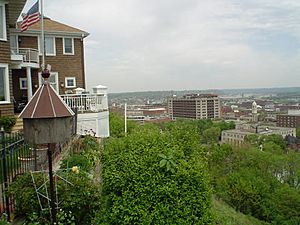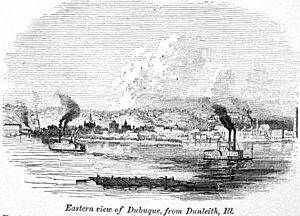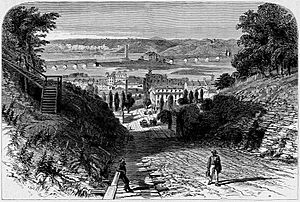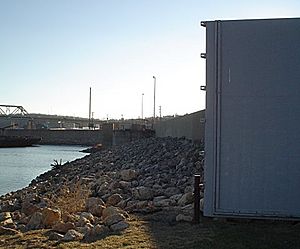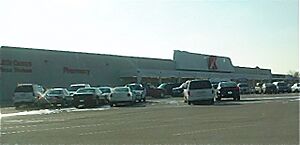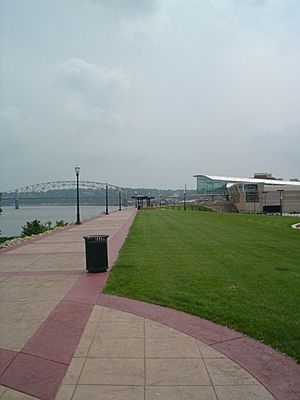History of Dubuque, Iowa facts for kids
The city of Dubuque, Iowa has a history stretching back over 200 years. It began when Julien Dubuque first settled in the area in the late 1700s. In more recent times, the city has focused on important topics like preventing floods, dealing with racial issues, and making the city better through redevelopment.
Contents
Early European Settlement
Dubuque was the very first permanent European settlement in what would later become the state of Iowa. This area was important for French and Native American fur trading. People started mining for lead here as early as 1690. A French trader named Nicholas Perrot was the first to record this.
In 1788, the Meskwaki people gave Julien Dubuque permission to mine their land for lead. He settled near the mouth of Catfish Creek. Dubuque, who the city is named after, is known as the first white person to settle in Iowa. You can still visit Julien Dubuque's tomb today. It is a local landmark.
City Growth and Development
In 1833, the United States government opened the area where Julien Dubuque lived to new settlers. Miners created a small community, which eventually grew into the city of Dubuque.
The first religious groups also started here. St. Luke's United Methodist Church is the oldest Methodist church in Iowa. It began when Methodist ministers arrived to work with the miners. A small Catholic church started in 1833. This church later became Saint Raphael's Cathedral.
In 1837, the Dubuque Diocese was created. This meant Dubuque became an important center for the Catholic Church in the region. Mathias Loras was appointed as the first bishop. When he arrived, there were only a few priests to serve a very large area covering several states.
Bishop Loras encouraged many immigrants to move to the area. They came from crowded cities in the eastern U.S. Many settled in Dubuque and nearby areas. Immigrants often lived near others from their home countries. This helped them adjust to their new nation.
Many Irish families came for cheap land and mining jobs. For many years, Irish families mostly lived in an area called Little Dublin. Later, a small group of Germans arrived. Over time, the German population grew. Germans became one of the two main ethnic groups in the city.
Today, other groups like Hispanics and African Americans have also become important parts of Dubuque. However, many people living in Dubuque are still descendants of those early German and Irish immigrants.
Dubuque During the Civil War
Many people from Dubuque served their country during the Civil War. Some of them later became important government leaders. David Bremner Henderson was a Representative in the U.S. House. He even became the Speaker around 1900. He was wounded in the war and lost a leg. William Boyd Allison also served. He later worked in both parts of Congress. Allison Henderson Park, located on University Avenue and Grandview Avenue, is named after these two men.
A few Dubuque citizens faced difficulties with the government during the war. George Wallace Jones was put in prison because of letters he wrote to Jefferson Davis. Newspaper publisher Dennis Mahony was also imprisoned for several months in 1862. This was because of articles he wrote that were critical of the government.
Many Catholics and immigrants in Dubuque did not support the Republican party. This was partly because some members of the Know Nothings movement, who had bothered them, had joined the Republican party. Sometimes, the President and other officials misunderstood this opposition as disloyalty. This helped make Dubuque a strong supporter of the Democratic party.
After the Civil War
The years after the Civil War were a time of great growth for Dubuque. When the Milwaukee Railroad Shops opened, many young German families moved to the area looking for jobs. This caused the population to grow very quickly.
Lead mining was no longer the main industry in Dubuque. Instead, the city became a transportation hub. This was because of its important location on the Mississippi River. The lumber industry also became very big in Dubuque.
The Ku Klux Klan was sometimes present in the area. In the 1920s, when the Klan was very powerful, its influence was seen in Dubuque. Several crosses were burned in the area over about 18 months. One Klan meeting near the Center Grove part of the city turned into a big fight. People who were against the Klan attacked Klan members. In 1925, the Klan held a large gathering they called a "Konklave." They claimed over 50,000 people attended. The Klan held another "Konklave" and a parade too.
Luckily, the Klan's influence soon started to fade. Problems within the Klan nationally and locally caused it to weaken. The Klan mostly disappeared from public view for many years. More recently, in the 1990s, the Klan briefly reappeared in Dubuque. However, proper actions were taken, and their presence has since gone away.
Modern History of Dubuque
After World War II, Deere and Company built a large factory north of Dubuque, opening in 1947. This plant, which makes construction equipment, became one of the biggest employers in the Dubuque area.
As television became popular, people in Dubuque found it hard to get TV signals. This was because of the city's hilly geography. So, a cable television system was created in Dubuque in the mid-1950s. This made Dubuque one of the first cities in the country to have cable TV. Because of this, most homes in the lower parts of the city did not need TV antennas. This was one reason why the movie F.I.S.T. was filmed there. Today, Mediacom operates the Dubuque cable system.
Dealing with Floods
Dubuque has experienced several serious floods over the years when the Mississippi River overflowed its banks. The Flood of 1965 was one of the worst in Iowa's history. In Dubuque, the water rose about 9.8 feet (3 meters) above flood level. Locals worked together to build temporary walls using sandbags.
After the 1965 flood, the city asked the government for money to build a permanent floodwall. This floodwall was finally built in the late 1960s. In 1993, when many parts of the Midwest had widespread floods, Dubuque's floodwall protected the city from serious damage. Other cities, like Davenport, Iowa, suffered a lot of damage.
In 1999, another major flood hit Dubuque. This led the city to take more action. One important project was "daylighting" the Bee Branch Creek. This means bringing the creek back to the surface where it can flow naturally.
Working on Racial Issues
In 1989, a cross was burned near an African-American family's home. Another cross was burned a few weeks later. These acts were done by a group of young men. Those responsible were later found guilty and sent to prison.
In 1992, the Ku Klux Klan held a rally in downtown Dubuque. To show that the city did not support the Klan, Dubuque held a free public gathering at Eagle Point Park. This event celebrated diversity.
Around the same time, the city started a plan to encourage more minority families to move to the area. John Deere also encouraged more minority workers to join their factory. Some people tried to create fear by spreading false rumors. In reality, the city planned to recruit African-American professionals to live and work in Dubuque.
The city's program and the cross burnings caused strong feelings in the community. People had very different opinions. At one point, Dubuque police had to go to Dubuque's Senior High School. This was because racial tensions almost led to a big fight. Jim Brady, who was mayor at the time, even visited schools to talk about his own experiences with racism. When the Guardian Angels arrived in Dubuque, some felt their presence would make things more complicated.
There were two more cross burnings in 2016. As of January 2020, about 3,000 African Americans lived in the city.
Moving Westward
During the second half of the 1900s, people and businesses in Dubuque started moving mostly to the western part of the city. This movement changed many areas of Dubuque. It also pushed the city's western boundaries further out. Many homes and businesses were built on land that used to be farm fields.
After World War II, many babies were born, which is called the baby boom. This impacted Dubuque. Many young families settled in the west end. Fields were turned into housing for these families, and Dubuque began growing westward. Because of this, the Archdiocese of Dubuque opened Wahlert High School, a central Catholic high school. The Dubuque Community School District opened Hempstead High School, the city's second public high school, in 1970.
During this time, many new businesses opened in Dubuque. The S. S. Kresge Corporation opened a new Kmart on what was once the western edge of Dubuque. This was the first Kmart in Iowa. Target Stores opened their own store about a mile west of Kmart in the late 1970s. In 1970, the first stores opened at Kennedy Mall. This was Iowa's first indoor, climate-controlled shopping mall.
Many businesses moved to the western part of the city. In 1964, Montgomery Ward moved its store from downtown to the west end. Both Wards and Roshek's Department Store moved into Kennedy Mall when it opened. In the 1980s, both JCPenney and Sears moved their stores from downtown to Kennedy Mall.
This move westward changed the downtown area. It became more of a business park instead of the main shopping area. After hours and on weekends, the area was often empty. The city has made many efforts to make the downtown area important again.
City Redevelopment Projects
In recent years, the city of Dubuque has worked hard to redevelop the downtown and riverfront areas. This included some decisions that caused debate. But so far, most people seem to have positive opinions about these efforts.
In the downtown area, a gas station that was shown in the movie Field of Dreams was torn down. This made space for more parking for downtown businesses. After that decision, the Bricktown Restaurant opened in the building behind where the gas station used to be. The owners made big improvements to the building. The local Historic Preservation Commission wanted the gas station to stay. However, the city government decided to remove it.
Many redevelopment efforts focused on the riverfront area, just north of the Ice Harbor. This was part of the America's River project. It included a newly expanded National Mississippi River Museum and Aquarium. Private investors built the Grand Harbor Resort and Waterpark on the riverfront. The Grand River Events Center was built next door. It is a place to host events for groups of all sizes. The old Dubuque Star Brewery nearby has also been updated. It now has spaces for businesses.
Developers suggested building a stadium near the Ice Harbor for a minor league baseball team. However, these plans were stopped. This happened when residents voted against a tax to help pay for the stadium.
Developers have also started building in the area at the bottom of the bluffs where Eagle Point Park is located. They plan to build condominiums there. This has caused some debate. People feel that buildings there would take away from the natural beauty of the area. The debate grew when several rockslides happened after construction began. The rockslides raised concerns that construction might be making the bluffs unstable.
The Dubuque Community School District decided to replace an old downtown elementary school building. They are building a new school a short distance away. This plan has faced opposition from groups who want to protect historic buildings. They say it would destroy several historic buildings. After looking at their options, the district decided to go ahead with building the new school. They have bought the properties that will be torn down. A section of W. 12th street has been closed. The street has been removed to make way for the new school building, named Prescott Elementary.
The building of new hotels has led to what the industry calls a "surplus" of rooms. This is especially true with the addition of the Grand Harbor Hotel and a new Hilton hotel at the Dubuque Greyhound Park and Casino. Because of this, the Best Western Dubuque Inn has been sold. Part of it was torn down, and the rest is being remodeled into a new hotel. The Dubuque Inn's owners also own the local Days Inn, which they have put up for sale. The owners of these two hotels said their rooms were often less than half full.
From June 27 to June 29, 2004, Dubuque hosted the Grand Excursion. This event traveled from the Quad Cities to the Twin Cities and stopped in Dubuque. It brought several riverboats, a steam locomotive passenger train, the Budweiser Clydesdales, and many people to the city.


